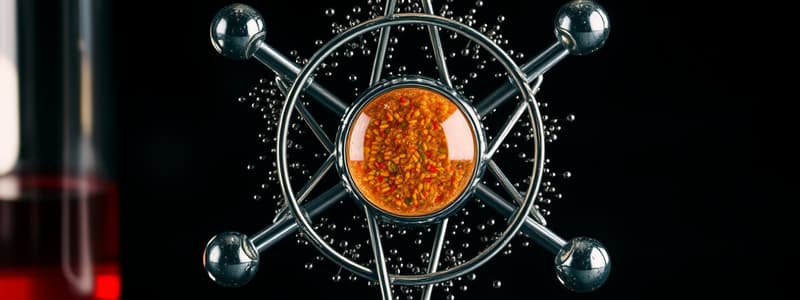Podcast
Questions and Answers
Which idea of Dalton's atomic theory may be violated by the chemical change represented by one green sphere and two purple spheres?
Which idea of Dalton's atomic theory may be violated by the chemical change represented by one green sphere and two purple spheres?
- Atoms are indivisible
- Atoms combine in simple whole-number ratios (correct)
- Atoms cannot be created or destroyed
- Atoms of a given element are identical
What postulate of Dalton's theory is consistent with the observation that 100 grams of calcium carbonate produces 44 grams of carbon dioxide and 56 grams of calcium oxide?
What postulate of Dalton's theory is consistent with the observation that 100 grams of calcium carbonate produces 44 grams of carbon dioxide and 56 grams of calcium oxide?
Conservation of mass
Which postulate of Dalton's theory is violated by the observation that different samples of titanium dioxide contain different percentages of titanium?
Which postulate of Dalton's theory is violated by the observation that different samples of titanium dioxide contain different percentages of titanium?
Atoms of a given element are identical
What do the data about compounds X, Y, and Z indicate in relation to the law of definite and multiple proportions?
What do the data about compounds X, Y, and Z indicate in relation to the law of definite and multiple proportions?
Which idea of Dalton's atomic theory is violated by the existence of isotopes?
Which idea of Dalton's atomic theory is violated by the existence of isotopes?
How are electrons and protons similar and how are they different?
How are electrons and protons similar and how are they different?
How are protons and neutrons similar and how are they different?
How are protons and neutrons similar and how are they different?
Predict the behavior of α particles fired at a 'plum pudding' model atom.
Predict the behavior of α particles fired at a 'plum pudding' model atom.
Study Notes
Dalton's Atomic Theory
- Dalton proposed a theory that includes postulates about the nature of atoms and chemical reactions.
- His theory suggests that atoms combine in fixed ratios to form compounds, which could be contradicted by observations of specific reactions.
Chemical Change
- In a reaction starting with one green sphere and two purple spheres, the product remains the same, indicating a potential violation of Dalton's assertion that compounds are formed and decomposed definitively.
Weights of Reactants and Products
- The law of conservation of mass supports the observation where heating 100 grams of calcium carbonate produces 44 grams of carbon dioxide and 56 grams of calcium oxide, totaling 100 grams, consistent with Dalton's postulate.
Titanium Dioxide Samples
- Variability in titanium percentages (59.95% vs. 60.10%) in different samples contradicts Dalton's postulate that compounds consist of the same proportion of elements.
Law of Definite and Multiple Proportions
- The data of compounds X, Y, and Z demonstrate both the law of definite proportions and the law of multiple proportions, indicating different ratios of carbon and hydrogen in each compound.
- Mass ratios between elements differ among compounds, confirming they are distinct substances despite similar appearance.
Isotopes and Dalton's Atomic Theory
- The existence of isotopes violates Dalton's idea that atoms of a given element are identical in mass and properties, as isotopes have different masses.
Electrons and Protons
- Electrons and protons are both fundamental subatomic particles in atoms.
- Similarities: Both have a charge; electrons are negatively charged and protons are positively charged.
- Differences: Electrons are much lighter than protons and are found in electron clouds, while protons reside in the nucleus.
Protons and Neutrons
- Protons and neutrons are found in the nucleus of an atom and collectively make up most of atomic mass.
- Similarities: Both have similar masses and contribute to the atomic mass.
- Differences: Protons carry a positive charge; neutrons are neutral.
Behavior of α Particles in Plum Pudding Model
- α particles would be predicted to pass through the atom with minimal deflection based on Thomson’s plum pudding model.
- The model suggests a diffuse distribution of positive charge, intending to explain why α particles would face little resistance.
Studying That Suits You
Use AI to generate personalized quizzes and flashcards to suit your learning preferences.
Description
This quiz explores Dalton's Atomic Theory and its implications for chemical reactions and compounds. It examines key concepts such as the conservation of mass and the law of definite proportions, while also addressing potential contradictions observed in various chemical reactions. Test your understanding of the foundational principles of chemistry.



